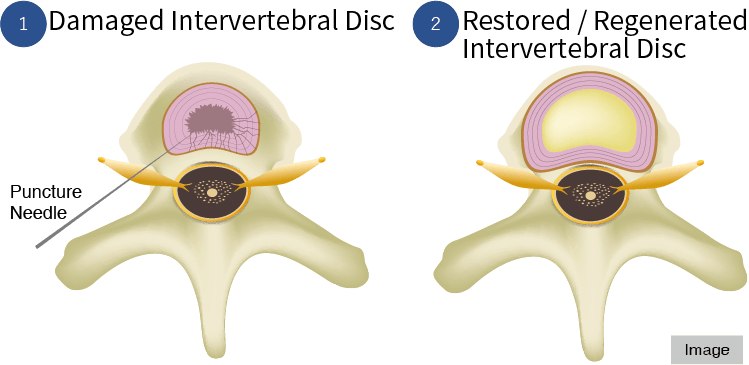Column Advantages and Disadvantages of Disc Herniation Disc Surgery. How to Avoid Risks and go Into Treatment With Peace of Mind
March 30, 2023
Disc herniation is the most common of back pain diseases.
It is a common disease that affects people in their 20s to 40s, and is accompanied by symptoms such as back pain, leg pain, and numbness and weakness in the lower limbs.
Treatment varies widely, including drug therapy, exercise therapy, nerve blocks, surgery, and intervertebral disc therapy.
Here we will discuss the advantages and disadvantages of each treatment for lumbar disc herniation.
The different treatments of disc herniation available
Treatment of lumbar disc herniation can be largely divided into conservative therapy (medication, exercise therapy, etc.) and surgery.
Conservative therapy
Once a herniated disc has been diagnosed, conservative therapy is the first step in most cases.
Medication
Medications include non-steroidal anti-inflammatory analgesics (such as Loxonin and Voltaren), muscle relaxants, opioid analgesics (such as morphine), and neuroleptics to reduce inflammation and pain.
・Advantages:
Relieves pain and other symptoms.
・Disadvantages:
Medication must be continued until the hernia is gone and symptoms disappear.
Patients with kidney or liver dysfunction may not be able to receive drug therapy. Side effects include drowsiness and dizziness. In addition, heavy use of opioid analgesics, especially opioid analgesics, may lead to drug dependence.
Exercise Therapy
When back pain occurs, the patient may rest, but extended periods of rest may lead to prolonged back pain. Therefore, instead of resting, rehabilitation exercises such as stretching may be performed to improve back pain.
・Advantages:
Stretching and other rehabilitative measures can relieve pain and other symptoms by strengthening the muscles.
・Disadvantages:
Incorrect or excessive exercise may aggravate back pain.
Nerve block
Nerve blocks are used when drug therapy has been deemed ineffective.
・Advantages:
Because it is an injection, there is no incision and the strain on the body is light.
・Disadvantages:
If the spinal canal stenosis is accompanied by a herniated disc, or if the patient is elderly, there is a possibility that nerve block injections will not be effective.
Prolonged nerve block injections may damage the nerves.
Basically, conservative therapy as described above is effective for discs at an early stage of herniation.
If symptoms do not disappear after several months of conservative treatment, surgical treatment is suggested.
Even in the early stages of the disease, surgery may be indicated if there are symptoms such as marked muscle weakness and sensory loss in the lower extremities, bladder, and rectal problems, etc.
Surgery
Surgery for lumbar disc herniation varies depending on the medical facilities.
Here we will describe the most commonly performed surgical procedures.
Hemi-semi-laminectomy (known as the L.O.V.E. procedure in Japan)
This has been a common surgical procedure for herniated discs in the past.
It is a surgical procedure performed under general anesthesia, in which a 5 cm to 10 cm incision is made in the back, avoiding the nerves around the spine using visual observation, and either a portion of the ligament or vertebral arch is shaved, or the herniated portion is removed.
・Advantages:
The procedure can be used for moderate to severe herniated discs.
The surgery is performed visually, so lesions are less likely to be missed.
It is covered by healthcare insurance.
・Disadvantages:
The incision is wider, which increases the strain on the body, and the hospitalization period is longer, from 2 to 3 weeks.
Micro Endoscopic Discectomy(MED)
This surgery is indicated for moderate to severe herniated discs.
The patient is placed in a prone position under general anesthesia, a 16mm incision is made in the back, an external canal and endoscope are inserted, and the endoscope is used to remove the protruding herniated portion after confirmation of the herniation.
・Advantages:
The surgical procedure is relatively short, taking about one hour.
Since the area of muscles to be cut is small, it results in minimal postoperative pain.
It is covered by health insurance.
・Disadvantages:
At 16 mm, the postoperative scar is rather large.
Hospitalization takes about 1 to 2 weeks.
Since surgery is a highly skilled procedure, it can only be performed at a specialized hospital with a high degree of expertise.
percutaneous endoscopic lumbar discectomy(PELD)
PELD surgery is performed when the size of the herniated disc is large and the pain felt is quite severe.
Under local anesthesia, a tube called an operation tube is inserted through the back, and the herniated disc is removed while checking the herniated area through an endoscope.
・Advantages:
The postoperative scar is small (6 to 7 mm) and unnoticeable.
The incision is small, and the postoperative pain is minimal.
Health insurance covers the procedure.
・Disadvantages:
It is difficult to perform the PELD procedure when the intervertebral space is narrow or when there is spinal canal stenosis or spondylolisthesis.
Percutaneous Laser Disc Discectomy (PLDD)
Under local anesthesia, a needle is inserted into the affected herniated disc from the back, and a laser fiber is passed through the path of the needle to burn the nucleus pulposus in the disc with a laser, thereby reducing nerve compression and improving pain and numbness.
・Advantages:
Effective not only for herniated discs but also for non-specific low back pain.
It is less physically demanding on the patient than the MED or LOVE methods.
The procedure takes only 15 minutes, so it can be performed as an ambulatory treatment.
・Disadvantages:
Not indicated for all types of disc herniation.
Not covered by healthcare insurance.
Percutaneous Ozone Disc Decompression (PODD)
PODD is indicated for mild herniation that does not require surgery and does not respond to conventional conservative treatment.
A needle is inserted into the herniated disc from the back under local anesthesia, and a mixture of ozone and oxygen is injected through the tip of the needle. Ozone oxidation reduces the volume of the herniated disc and relieves compression on the nerve.
Because of the anti-inflammatory effect on the affected area, patients who are not eligible for laser therapy (PLDD) can also undergo the treatment.
・Advantages:
The surgery takes less time, and the postoperative scar is smaller.
Less risk of side effects and complications.
Treatment can be performed as an ambulatory treatment.
It is less invasive than PLDD, with no risk of discitis (which may rarely occur due to the heat of the laser).
・Disadvantages:
Not effective for all hernias.
Pain relief is limited, and multiple procedures may be required.
Not covered by healthcare insurance.
Hybrid Laser Therapy
Hybrid surgery with PLDD and ozone has the effect of removing the underlying cause of the compression from the nucleus pulposus protruding, and directly suppressing the inflamed area with ozone.
・Advantages:
The surgery is short, and the postoperative scar is small.
It is more effective than PLDD or PODD because it eliminates the hernia and treats the inflammation at the same time.
・Disadvantages:
Not effective on all hernias.
Not covered by healthcare insurance.
The Cellgel method (disc repair by a gel-like implant)
This is one of the advanced treatment methods that have been researched and developed in recent years, and is the newest treatment method based on solid evidence.
It can repair the disc, which is the root cause of disc herniation.
It is characterized by the fact that it does not reduce the volume of the intervertebral disc, and the drug remains in the disc as a gel-like implant after treatment, thus preserving the disc.
(Image of the Cellgel Treatment)

・Advantages:
Because it enables the “repair the intervertebral disc,” which is not possible with other treatment methods, it can be considered a curative treatment at the root level.
It is applicable to a wide range of diseases, and is not only restricted to herniated discs.
It can be performed as a ambulatory treatment.
Treatment is available for patients who have had no relief from pain after surgery or who had a recurrence of pain.
Treatment is also available for elderly patients over 80 years old.
・Disadvantages:
The treatment is not applicable to cases where the intervertebral disc has lost most of its volume.
The treatment cost is high because it is an independent treatment.
If you have been diagnosed with a herniated disc and are in pain, and if you want to avoid spinal surgery, or if your herniation has recurred, please visit our clinic for a consultation,
We are waiting for you for a consultation at our clinic.
Written by the Administrative Director at ILC International Lumbago Clinic Tokyo



